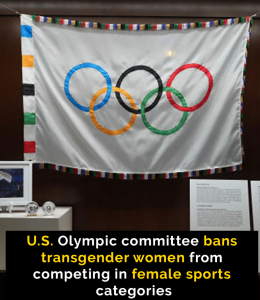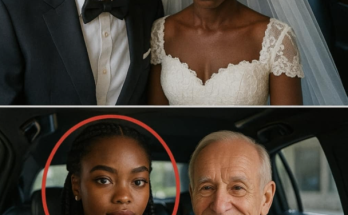🚨 Policy Shift: Ban Announced
Mid‑July 2025, the U.S. Olympic & Paralympic Committee (USOPC) quietly updated its Athlete Safety Policy, effectively barring transgender women (individuals assigned male at birth) from competing in women’s sports divisions. The revision doesn’t use the word “transgender” outright, but explicitly states that USOPC will comply with Executive Order 14201, titled “Keeping Men Out of Women’s Sports”, issued by President Donald Trump in February 2025
A letter sent to roughly 50 national governing bodies—including USA Swimming, USA Track & Field, and USA Fencing—made clear these bodies have an “obligation to comply” with the federal directive. They must update their eligibility regulations to align with the policy change
🏛️ Executive Order & Legal Basis
Executive Order 14201 directs federal, state, and educational institutions not to allow transgender girls and women to compete in teams corresponding with their gender identity. Violations risk loss of federal funding under Title IX — the 1972 civil rights law that bans sex discrimination in education programs receiving federal financial assistance
Moreover, the move is supported by the Ted Stevens Olympic & Amateur Sports Act (1978), which gives USOPC the legal authority—and responsibility—to implement federal expectations for fairness and athlete safety through collaboration with Olympic stakeholders (IOC, IPC, NGBs)
🔍 Why the Ban Now?
Political pressure has been mounting. Former President Trump framed this as part of a broader cultural agenda to protect women’s sports, culminating in the executive order. The NCAA already moved in February to limit collegiate women’s teams to athletes designated female at birth, reinforcing a U.S.-wide standard
This shift aligns the USOPC with these institutional decisions, moving away from its earlier practices grounded in internal scientific committees and more individualized assessments of athletic eligibility. Critics say it’s a reversal of evidence‑based inclusion protocols in favor of rigid political mandates
🌎 International vs National Standards
The U.S. move contrasts sharply with International Olympic Committee (IOC) policy, which since 2021 has allowed athletes to compete under sport-specific criteria, including hormone levels and transition timelines. The IOC currently permits transgender athletes—but the U.S. decision diverges from much of that guidance
IOC President Kirsty Coventry recently called for a global, scientifically grounded eligibility framework, but reaffirmed that national bodies still control domestic policy. A working group has been initiated, but no binding universal standards have been agreed upon offering uniform inclusion rules
🌍 Scope and Implementation
Effective August 1, 2025, national federations must implement updated policies. For example, USA Fencing announced changes to their rules: only those “of the female sex” (i.e., assigned female at birth) may compete in women’s events. The men’s and open divisions are now inclusive of transgender women, transgender men, non‑binary, intersex, and cisgender men
Additional policies may apply in other sports, such as swimming, track and field, and cycling—many already restrict eligibility based on whether an athlete underwent male puberty
Questions remain for athletes like Nikki Hiltz, a nonbinary runner assigned female at birth, who represented Team USA at the Paris 2024 Olympics. Because policies target transgender women only, Hiltz may not be directly affected—but uncertainty remains over eligibility changes at national or local levels
📋 Scientific Debate & Public Reactions
Scientific Evidence
Several studies—including one funded by IOC affiliates—indicate that transgender women undergoing at least 12 months of hormone therapy may lose muscle mass and strength, potentially narrowing performance gaps. However, other long-term physiological differences, such as bone structure, height, and lung function, may persist and confer competitive advantage in some sports
Some scientists and sports ethicists warn against premature, blanket bans, arguing for sport‑specific rules based on evidence—particularly cautioning against policies not backed by research
Support and Condemnation
Supporters—such as swimmer Riley Gaines—have praised the USOPC and federal leadership for protecting fairness in women’s sports. The decision is seen as a landmark validation of Title IX principles by gender-rights activists within the Republican base
Opponents, including the National Women’s Law Center and Athlete Ally, strongly criticized the decision. They argue the policy abandons marginalized athletes, erodes inclusion, and is coercive: driven by political pressure rather than current science or athlete welfare considerations
⚖️ Legal Challenges Ahead
Multiple state laws and court cases are already testing bans on transgender youth in school sports—some have been blocked on constitutional grounds. Given the USOPC’s federal compliance rationale, its policy may invite lawsuits challenging discrimination under Title IX or other civil rights protections
The U.S. Supreme Court has agreed to hear cases on such bans, with final decisions expected to clarify national legal boundaries around transgender athletes’ rights and athletic eligibility
🔮 What’s Next?
-
Domestic implications: Athletes at high school, collegiate, masters, and youth levels may face policy changes aligning with national governing bodies. Universities and clubs might risk losing federal funds if their rules conflict with federal mandates.
-
International conflict: As U.S. policy deviates from IOC guidance, selection criteria for international events like LA 2028 Olympics could become complicated.
-
Policy backlash: Ongoing advocacy, petitions, and activism may challenge the constitutional and ethical legitimacy of the ban, perhaps leading to revisions or rollbacks.
-
Broader cultural impact: The policy is embedded within a broader political culture war over transgender inclusion, with implications beyond sport—including education policy, healthcare access, and civil rights.
🧭 In Summary
The USOPC’s updated policy—effective August 1, 2025—marks a major shift: transgender women will no longer be permitted to compete on U.S. women’s Olympic or Paralympic teams. The move is driven by Executive Order 14201, backed by demands for consistency under the Ted Stevens Act. National governing bodies must enforce compliance by overhauling their eligibility regulations.
While supporters argue it protects fairness for cisgender female athletes, critics say the decision abandons scientific nuance, undermines inclusion, and targets a tiny subset of athletes without evidence of widespread advantage. Legal challenges are likely, and the U.S. now stands at odds with global sports authorities like the IOC.

